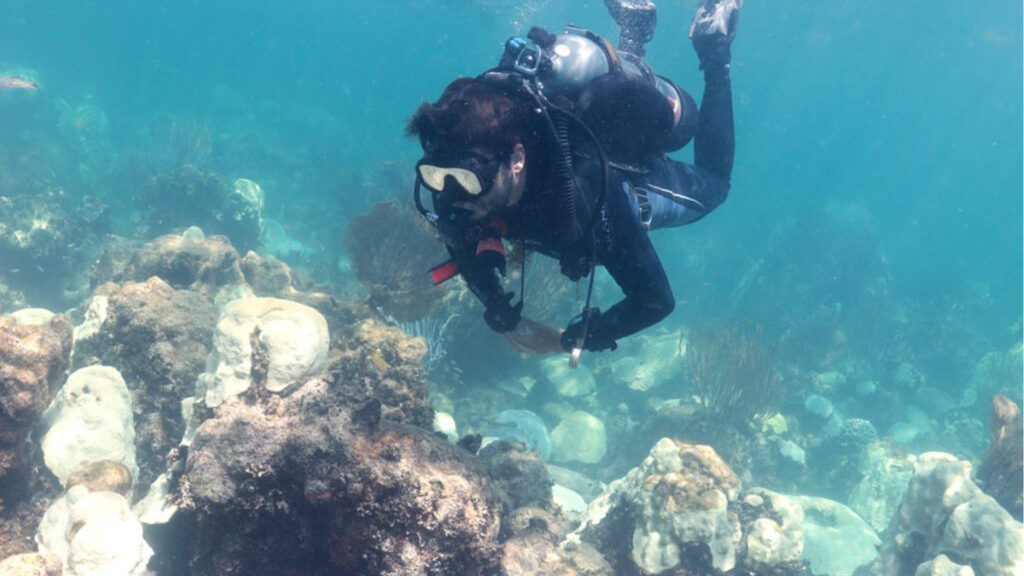By Mia McCormick, Environment Florida
Ocean temperatures are rising earlier each year, putting many of the corals that make up the diverse underwater wilderness of Florida’s reef at risk of bleaching and ultimately death.
This reef tract is a gem of colorful fish, crustaceans and unique corals. It’s home to a variety of endangered species and native wildlife you can only find in these waters.
After the warmest summer ever recorded in the Florida Keys National Marine Sanctuary last year, everyone working to protect our state’s imperiled coral reefs is kicking into high gear. The coral loss due to high temperatures, disease outbreak and human activity was record breaking, devastating entire genotypes of sensitive coral and beds of seagrass at some sites.
This year, temperatures are already 1 to 2 degrees higher than normal and a bleaching warning went into effect in mid-May. Last year that warning wasn’t issued until June.
Deep water refuges

The sanctuary is managed by the National Oceanic and Atmospheric Administration (NOAA); It’s home to roughly two-thirds of Florida’s coral reef tract. Several groups are working to grow and restore coral within the sanctuary, and some of them lost entire nurseries last year when temperatures stayed above the bleaching threshold for more than three months. Emergency measures were taken to evacuate growing corals to land-based facilities or a temporary deep water nursery.
In a meeting of the Florida Keys National Marine Sanctuary Advisory Council on June 18, NOAA officials outlined how they were able to use an emergency rule in the sanctuary’s management plan to designate an area off of Key Largo to become a temporary deep water recovery site. That deep water nursery saved many of the corals that were already showing signs of bleaching stress. Those that survived were eventually moved back into shallow water to make sure they receive the light and nutrients they need.
The success of the deep water site has prompted NOAA to prepare to enact the emergency rule again this year, with two additional sites. One crucial element to allowing these stressed corals to recover is to restrict activity around them. That’s why NOAA is holding public comment about the two new sites and their locations.
The emergency designation would close these waters off to entry without a permit. Vessels on top of the water can continue through, but no one will be allowed into the water with the corals.
Officials are looking for feedback on the new sites, particularly from fishermen and tourism vessels that operate in the area and may be affected. They stressed that this is not a long-term solution, but instead a strategy that can be used until a long-term solution is devised.
Preparing for record-breaking heat
Meanwhile, restoration teams are prepping for what promises to be another record-breaking summer. Three groups presented their summer plans during the advisory council meeting, some common actions include enhancing gene banks and nurseries with more heat-tolerant coral genotypes and moving the corals to the deep water sites sooner. Corals are grown on tree-like structures underwater and one of the groups is lowering those trees to bring the corals away from the surface where temperatures tend to be hottest.
New technology will be tested in coral nurseries as well. Intermittent shade structures that look like small square sails underwater are being attached to nursery trees to provide shade for part of the day. About 30 nursery trees will be adapted with a new Underwater Zooplankton Enhancement Light Array, designed to attract zooplankton, coral’s main food source, to enhance their ability to feed during the summer months.
Taking action to reduce ocean temperatures
Despite these efforts, we know corals will bleach and die until we are able to lower our greenhouse emissions and reduce the amount of fossil fuels that we consume. Those gasses warm our planet and global ocean temperatures will continue to rise.
We all have the ability to make changes, big or small, to our lifestyle to reduce our carbon footprint. The state is currently making a plan to distribute millions of federal dollars that will help Floridians make their homes more energy efficient.
Funding from the Bipartisan Infrastructure Law is taking dirty diesel school buses and vehicle fleets off the roads and replacing them with clean energy electric buses. And every time you choose to walk, bike or take public transportation, you are making a better choice for Florida coral.
Here’s a quick list of 12 ways to pledge support for coral reefs from the International Coral Reef Society.
Mia McCormick is an advocate with Environment Florida, a policy and action group with one mission: to build a healthier, greener Sunshine State. This piece was originally published at https://environmentamerica.org/florida/articles/ocean-temperatures-rise-as-teams-prepare-to-save-corals/.
If you are interested in submitting an opinion piece to The Invading Sea, email Editor Nathan Crabbe at ncrabbe@fau.edu. Sign up for The Invading Sea newsletter by visiting here.



